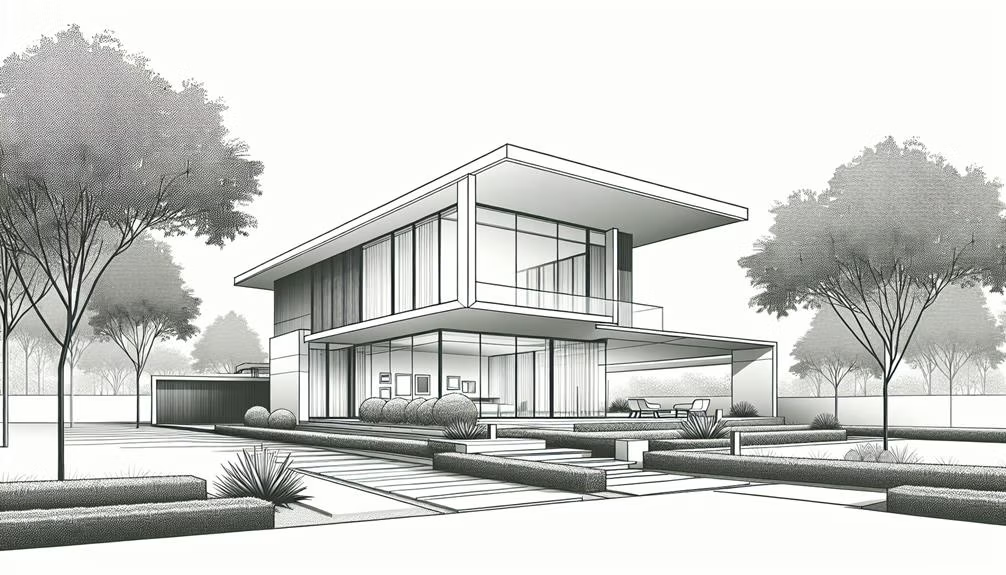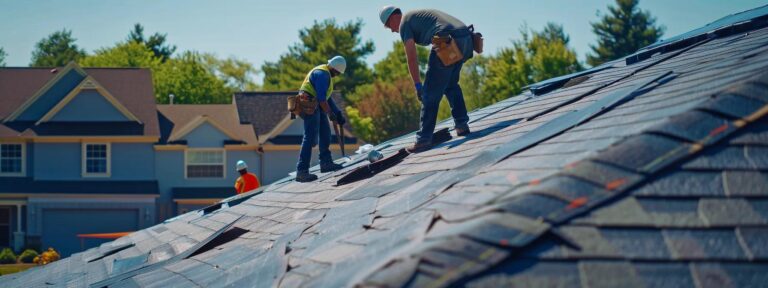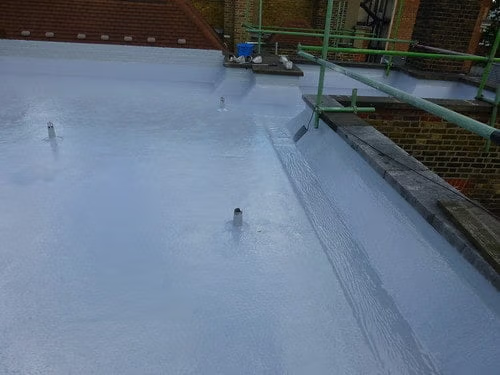A flat roof offers several advantages, making it a practical and appealing choice for both residential and commercial properties. It is cost-effective due to lower installation and repair costs. Maintenance is straightforward, allowing safe and fast access for inspections and minor repairs. The design provides extra outdoor space for gardens, lounges, or utility installations. Flat roofs also enhance energy efficiency through reflective coatings and green roof systems.
Aesthetic appeal is another benefit, offering a sleek, modern look that seamlessly blends indoor and outdoor spaces. Discover more about how flat roofs can suit your specific needs and preferences.
Key Takeaways
- Flat roofs offer lower installation and repair costs, making them cost-effective.
- They provide easy and safe access for routine inspections and maintenance.
- Extra outdoor space on flat roofs can be used for gardens, patios, or solar panels.
- Flat roofs enhance energy efficiency through reflective coatings and green roof systems.
- They deliver a modern, sleek aesthetic and versatile design options for buildings.
Cost-Effectiveness

One of the primary advantages of a flat roof is its cost-effectiveness, making it an attractive option for both residential and commercial buildings. The initial installation costs are generally lower than those of pitched roofs due to the simpler design and reduced materials required. Since flat roofs do not necessitate complex structural elements, labor costs are also minimized. This financial benefit extends beyond the initial installation, as the straightforward design of a flat roof often leads to lower repair costs over time.
In addition to the reduced upfront costs, flat roofs offer economic advantages in terms of space utilization. The horizontal surface can be used for various purposes, such as installing HVAC systems, solar panels, or even creating a rooftop garden. This dual functionality can result in further savings and potentially generate additional revenue or energy savings, enhancing the overall value of the property.
Moreover, the simplified design of flat roofs facilitates faster installation, reducing the time and labor required. This efficiency not only saves money but also minimizes disruptions to building occupants or business operations. In summary, the cost-effectiveness of flat roofs makes them a practical and financially savvy choice for many construction projects.
The Advantages of Flat Roofs: Design and VersatilityEasy Maintenance
Due to their straightforward design, flat roofs are notably easier to maintain compared to their pitched counterparts. This simplicity results from their horizontal structure, which provides easy access for inspections, cleaning, and minor repairs. Regular upkeep is crucial for any roofing system, and flat roofs make this task much more manageable.
Flat roofs offer several specific maintenance advantages:
- Accessibility: The flat surface allows for safe and straightforward access, reducing the need for specialized equipment.
- Ease of Inspection: Routine inspections can be performed quickly, facilitating early detection of potential issues such as leaks or drainage problems.
- Simplified Cleaning: Debris like leaves and dirt can be removed effortlessly, preventing blockages and water pooling that could lead to damage.
- Cost-Effective Repairs: Minor repairs can be conducted without extensive labor or complex scaffolding, thereby saving time and money.
These benefits collectively makeflat roofs a practical choice for residential and commercial properties alike. The simplicity in maintenance not only ensures longevity but also contributes to lower long-term costs. It’s clear that the ease of maintaining a flat roof is a significant advantage, making it an attractive option for property owners seeking efficiency and reliability.
Extra Outdoor Space

Flat roofs provide an additional outdoor area that can be utilized for various purposes, enhancing the functionality and value of the property. This extra space can serve multiple uses, transforming an otherwise underutilized part of the building into a versatile asset. For residential properties, a flat roof can be designed as a rooftop garden, offering a green retreat for relaxation and leisure. It can also be converted into a patio area, perfect for hosting gatherings and enjoying outdoor activities without leaving home.
In urban environments, where space is often at a premium, flat roofs can become prime real estate. Commercial buildings can leverage flat roofs to create outdoor lounges or recreational spaces for employees, contributing to a more enjoyable work environment. Additionally, restaurants and cafes can use this space for rooftop dining, providing a unique experience that can attract more customers and boost revenue.
Moreover, flat roofs can accommodate solar panels, satellite dishes, or HVAC systems without compromising the building’s aesthetics or usability. This flexibility makes flat roofs an attractive option for property owners looking to maximize their investment. Ultimately, the ability to repurpose this additional outdoor space underscores the practical and economic benefits of flat roof designs.
Energy Efficiency
Harnessing the energy efficiency of flat roofs can lead to significant cost savings and environmental benefits for property owners. Flat roofs, when properly designed and maintained, offer an array of features that enhance energy efficiency and sustainability. One of the primary advantages is their compatibility with modern insulation techniques and energy-saving technologies.
Flat roofs can be optimized with the following energy-efficient enhancements:
- Reflective Coatings: Applying reflective or cool roof coatings helps deflect sunlight, reducing heat absorption and lowering cooling costs during hot weather.
- Green Roof Systems: Incorporating vegetation on flat roofs provides natural insulation, reduces urban heat island effects, and improves air quality.
- Solar Panels: The large, unobstructed surface area of flat roofs is ideal for installing solar panels, enabling property owners to generate renewable energy and decrease reliance on non-renewable sources.
- Advanced Insulation Materials: Flat roofs can be fitted with advanced insulation materials that enhance thermal performance, keeping interiors warmer in winter and cooler in summer.
Modern Aesthetic

How can flat roofs contribute to a property’s modern aesthetic while offering functional benefits? Flat roofs have become synonymous with contemporary architecture, providing a sleek, minimalist appearance that complements modern design principles. Their clean, horizontal lines contrast effectively with the traditional pitched roof, adding a distinctive architectural flair.
One of the primary aesthetic advantages of flat roofs is their ability to create a seamless blend between indoor and outdoor spaces. This integration is particularly appealing in urban settings, where maximizing space is crucial. Flat roofs can easily be transformed into rooftop gardens, terraces, or lounge areas, significantly enhancing the property’s visual appeal and usable area.
Furthermore, flat roofs offer a canvas for innovative design elements. Solar panels can be installed without disrupting the roof’s aesthetic, and skylights can be incorporated to flood interiors with natural light, all while maintaining the modern look. This versatility in design allows homeowners and architects to experiment with new materials and finishes, further accentuating the property’s contemporary style.
Frequently Asked Questions
How Does a Flat Roof Handle Heavy Rainfall or Snow Accumulation?
A flat roof handles heavy rainfall or snow accumulation through efficient drainage systems such as internal drains, scuppers, or gutters. Proper design includes a slight pitch to direct water towards these outlets, preventing pooling and potential structural damage. Additionally, regular maintenance ensures that these drainage components remain unobstructed, effectively managing the load from precipitation and minimizing risks associated with water or ice accumulation.
What Materials Are Commonly Used for Flat Roofs?
A flat roof, akin to a blank canvas, offers versatile material options. Commonly used materials include modified bitumen, known for its durability; EPDM (ethylene propylene diene terpolymer), a synthetic rubber offering excellent weather resistance; and TPO (thermoplastic olefin), which is energy-efficient and recyclable. Each material optimally addresses specific performance needs, ensuring that flat roofs remain functional and resilient under various environmental conditions.
Can a Flat Roof Support Solar Panel Installations?
Yes, a flat roof can support solar panel installations effectively. The flat surface allows for optimal orientation and angle adjustment of the panels to maximize sunlight exposure. Additionally, flat roofs offer ample space for the installation of multiple solar panels, enhancing energy generation. Proper structural assessment and reinforcement may be necessary to ensure the roof can bear the additional weight of the solar panels and related equipment.
Are Flat Roofs Suitable for All Climate Types?
When considering the suitability of flat roofs across diverse climates, one must tread carefully. While flat roofs offer design flexibility, they may present challenges in regions with heavy snowfall or rainfall, potentially leading to water accumulation and leakage. In milder or arid climates, however, they perform admirably, providing ease of maintenance and additional usable space. Consulting a roofing expert ensures the choice aligns with local environmental conditions.
How Long Do Flat Roofs Typically Last Compared to Pitched Roofs?
The lifespan of flat roofs typically ranges from 10 to 20 years, depending on materials and maintenance practices. In contrast, pitched roofs generally offer a longer lifespan, often lasting between 20 to 50 years with proper care. Factors such as weather exposure, quality of installation, and frequency of inspections significantly influence the longevity of both roof types. Regular maintenance can help extend the life of any roofing system.
Conclusion
A flat roof offers numerous advantages, such as cost-effectiveness, simplified maintenance, and additional outdoor living space. Its design can yield significant energy savings, contributing to an eco-friendly footprint. Moreover, the sleek, modern aesthetic aligns with contemporary architectural trends.
These benefits collectively underscore the practicality and visual appeal of flat roofs, making them a prudent choice for both residential and commercial structures. Embracing such a design can thus be seen as a strategic investment in both functionality and style.






